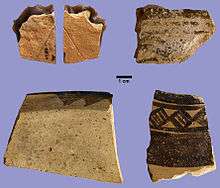Dosariyah
 Shown within Saudi Arabia | |
| Alternate name | Dawsariyyah, Dosarije |
|---|---|
| Location | Jubail |
| Region | Eastern Province |
| Coordinates | 26°52′37″N 49°49′05″E / 26.877°N 49.818°E |
| History | |
| Periods | Neolithic |
| Site notes | |
| Excavation dates |
1972 2010-present |
| Archaeologists |
G. Burkholder H. Masry P. Drechsler |
| Public access | No |
Dosariyah is an archeological site in the Eastern Province, Saudi Arabia, dating to the late 6th and early 5th millennium BCE. The spectrum of archaeological remains relate the site to the Arabian Neolithic. The earliest samples of Ubaid style pottery in Saudia-Arabia were found at Dosariyah.

Location
The site is located about 12 km south of Jubail and 800 m inland from the present coastline of the Persian Gulf. Today it represents an approximately north-south orientated flat hill elevating about 2 m above the regular ground without a direct line of sight on the Gulf. Southwards lies the Sabkha as-Summ. The surrounding area is dominated by dunes and spare vegetation.
Discovery
Grace Burkholder first discovered Dosariyah in 1968. Scattered all over the area she found great amounts of painted and unpainted pieces of pottery, stonetools made from Silex and Obsidian, Seashells, bones of mammals and fish as well as plaster. In the same year, Geoffrey Bibby dated the pottery to the Ubaid period and suggested further investigation on the site. In 1972 Abdullah H. Masry proofed at least 7 layers containing settlement debris to a depth of 2.50 m, separated by layers with only few finds. After these first excavations a massive fence was built around the site to protect it. Since 2010 a joint Saudi-German team from the Dammam Regional Museum and the University of Tübingen is re-excavating Dosariyah.
Dating
The range of findings as well as the stratigraphy date the main time of Dosariyah’s habitation to the Arabian Neolithic and the Ubaid period. Radiocarbon dates from shells verify this assumption, dating to the late 6th and the early 5th millennium BC. Except a single potsherd from the Islamic Period and modern debris found on the surface there are no indicators for later settlements at this site. The good preservation of organic material makes Dosariyah an excellent example for the investigation of the Neolithic on the Arabian Peninsula.
Pottery and Function of the Settlement
The findings of Dosariyah contain elements of the local Arabic Neolithic as well as influences from southern Mesopotamia. Especially the large amount of imported Ubaid style pottery from southern Mesopotamia suggests intense cultural contacts. About 25% of Dosariyah’s pottery is tempered with straw and minerals. This, therefore called “Coarseware”, is seen as a local pottery tradition. Ubaid style pottery is found at various sites along the southern coast of the Persian Gulf. Even though lots of these sites contain only few Ubaid style sherds the great deal of imported pottery and obsidian at Dosariyah suggests its relevance within an extensive social and economic network. Several, up to 50 cm thick layers containing mostly shells of pearl oyster Pinctada radiata could be seen as evidence for pearling. If Dosariyah was a permanently inhabited settlement or a periodically used encampment established by herding nomads for trading, fishery etc. is object of the current investigations.
References
- Geoffrey Bibby: Looking for Dilmun. Knopf, New York 1969, ISBN 0-394-43400-5
- Geoffrey Bibby: Preliminary survey in East Arabia 1968. Gyldendal, Copenhagen 1973, ISBN 87-00-91091-0
- Grace Burkholder: Ubaid Sites and Pottery in Saudi Arabia. In: Archaeology 25 (4), pp. 264–269, 1972
- Robert Carter & Harriet Crawford: Maritime Interactions in the Arabian Neolithic. The Evidence from H3, As-Sabiyah, an Ubaid-related site in Kuwait. Brill, Leiden 2010, ISBN 978-90-04-16359-1
- Philipp Drechsler: Places of contact, spheres of interaction. The Ubaid phenomenon in the central Gulf area as seen from a first season of reinvestigations at Dosariyah (Dawsāriyyah), Eastern Province, Saudi Arabia. In: Proceedings of the Seminar for Arabian Studies 41. 2011
- Abdullah Hassan Masry: Prehistory in northeastern Arabia. The Problem of Interregional Interaction. Kegan Paul International, London and New York 1997, ISBN 0-7103-0536-2
- L.J. Oates, D. Kamilli, H. McKerrel: Seafaring Merchants of Ur? In: Antiquity 51 pp. 221–234, 1977
- M. Roaf, J. Galbraith: Pottery and p-values: 'Seafaring merchants of Ur?' re-examined. In: Antiquity 68 (261), pp. 770–783, 1994